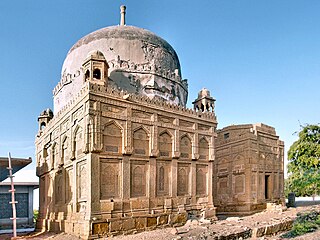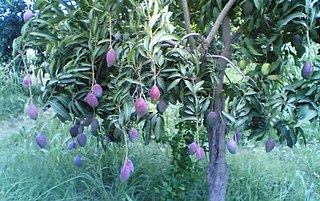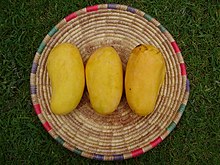
A mango is an edible stone fruit produced by the tropical tree Mangifera indica. It originated from the region between northwestern Myanmar, Bangladesh, and northeastern India. M. indica has been cultivated in South and Southeast Asia since ancient times resulting in two types of modern mango cultivars: the "Indian type" and the "Southeast Asian type". Other species in the genus Mangifera also produce edible fruits that are also called "mangoes", the majority of which are found in the Malesian ecoregion.

Mirpur Khas is a village in Sindh province, Pakistan.. The city was built by Talpur rulers of Mankani branch. According to the 2017 Census of Pakistan, its population is 205913. Mirpur Khas is known for its mango cultivation, with hundreds of varieties of the fruit produced each year - it is also called the “City of Mangoes,” and has been home to an annual mango festival since 1955. After the completion of Hyderabad-Mirpurkhas dual carriage way, the city has become hub of commercial activities.

Tando Allahyar is a city and capital of Tando Allahyar District located in Sindh, Pakistan. It is the 56th largest city of Pakistan by population according to the 2017 census.

Sindhri is the biggest area and a town located in the Mirpur Khas District of the Sindh province of Pakistan. Previously, it was part of Tharparkar District in Sindh. Muhammad Khan Junejo, former prime minister of Pakistan, was born in this town.

Chaunsa, also known as chausa, is a mango cultivar indigenous to South Asia. It is grown mainly in India and Pakistan; both countries export significant quantities of the fruit.

Mirpur Khas District is one of the districts in the province of Sindh, Pakistan. Its capital is Mirpur Khas city.

Khipro is a tehsil of Sanghar district. Its headquarters are in Khipro town. It is bounded to the east by India.

Mirpur Khas Division is an administrative division of the Sindh Province of Pakistan. It was abolished in 2000 but restored again on 11 July 2011. formerly a part of Hyderabad Division. CNIC code of Mirpur Khas Division is 44.

The Dasheri mango is a mango cultivar which originated in a village near Kakori in Lucknow district in 18th century. It is a sweet and fragrant variety of mango grown in North India, the southern state Andhra Pradesh, Nepal, and Pakistan. Malihabad in Uttar Pradesh is the largest producer.
Lodhran, is a city and the capital of Lodhran District in the Punjab province of Pakistan. It is Pakistan's 81st largest city. It is located on the northern side of River Sutlej. Lodhran is famous for its cotton crop and mangoes.

Oidium mangiferae is a plant pathogen that infects mango trees causing powdery mildew. Powdery mildew of mango is an Ascomycete pathogen of the Erysiphales family that was initially described by Berthet in 1914, using samples collected from Brazil. O. mangiferae is found in all areas where mangoes have been raised long term, but is particularly widespread in India where both the host and the pathogen are native. Currently no teleomorph stage has been identified, but due to certain morphological characteristics it has been suggested that O. mangiferae belongs in the Erysiphe polygony group. Mango is the only known host for this pathogen, though O. mangiferae appears to be identical to fungi responsible for powdery mildew diseases on various other plant species, particularly oak, though some differences may be observed. In particular, the number of cells in conidiophores varies from 2 on mango to 3-5 on oak. O. mangiferae has been known to infect oak leaves in the laboratory, however due to the lack of a known teleomorph stage O. mangiferae is still considered to only be a pathogen of mango. Recent analysis of its ribosomal DNA suggests it is conspecific with Erysiphe alphitoides, the causative agent of powdery mildew in European oaks.
Zarina Baloch was a Sindhi folk music singer, vocalist and composer from the Sindh province of Pakistan. She was also an actress, Radio and TV artist, writer, teacher for over 30 years, political activist and social worker. She is notable for her revolutionary songs and resistance against the military dictatorship of General Zia

The 'Shan-e-Khuda' mango is a late-season mango cultivar grown in Pakistan, specifically the Multan and Rahim Yar Khan districts.
Mehrabpur, (Sindhi:محرابپور), is a city in the Naushahro Feroze District in the Sindh province of Pakistan. The city is administratively subdivided into 8 Union Councils. It has a busy railway station on the main railway line between Karachi and Lahore. It is a junction station with a disused branch line to Naushahro Feroze.

Banganapalle mangoes is a mango variety produced in Banganapalle of Nandyal District in the Indian state of Andhra Pradesh. It alone occupies 70% percent of total mango cultivable area of the state and was first introduced by the farmers of Banaganapalli. It was registered as one of the geographical indication from Andhra Pradesh on 3 May 2017, under horticultural products by Geographical Indication Registry. It is also grown in the other parts of India and Pakistan. The fruit is described as obliquely oval in shape, around 20cm in length, with yellow flesh and a thin, smooth yellow skin. The flesh is of a firm, meaty texture and is sweet and lacks fibre. The cultivar is the most sought after in Andhra Pradesh. It is a very late-season variety that is good for canning. This cultivar is a source of vitamin A & C and is also called king of Mangoes.
Kot Ghulam Muhammad is named after Ghulam Muhammad Khan Bhurgri, the Tehsil situated in south-east Mirpur Khas District of the Southern Province Sindh in Pakistan. Kot Ghlam Muhammad Bhurgri is situated west of Samaro and north of Digri. It is about 45 kilometres (28 mi) south of Mirpur Khas.
Hingorno is a small town situated in Taluka Sindhri, Mirpur Khas District, Sindh, Pakistan. The town has a population of 35000.The Chairperson of Town Community Hingorno Rukhsan Shar and Vice Chairmen Mohammad Ismail Shekh.
Hyderabad Expo Center was established by now defunct City District Government Hyderabad (CDGH) by the Mayor of Hyderabad, Kunwar Naveed Jamil. The main aim of the Expo Center is to introduce agricultural and industrial production of Hyderabad District, Sindh in the International market.

Anwar Ratol is a small, yellow variety of mango known for its sweetness and fiberlessness. It is sometimes called the 'mini powerhouse'. It is cultivated in the Punjab and Sindh regions of Pakistan, and near the village of Rataul in Uttar Pradesh, India. It is very sweet in taste with less fiber.














